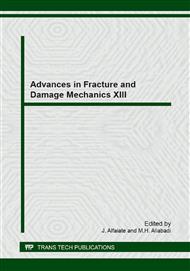[1]
T. Ponikiewski, J. Katzer: Properties of fresh SCC mix reinforced by different types of steel and polymer fibre, Construction and Buildings Materials, V. 62, (2014), pp.96-101
DOI: 10.1016/j.conbuildmat.2014.03.037
Google Scholar
[2]
J. Katzer: Strength performace comparison of mortars made with waste fine aggregate and ceramic fume, Construction and Buildings Materials, V. 47(2013), pp.1-6
DOI: 10.1016/j.conbuildmat.2013.04.039
Google Scholar
[3]
I. Merta, E.K. Tschegg, Fracture energy of natural fibre reinforced concrete, Construction and Building Materials, V. 40 (2013) pp.991-997
DOI: 10.1016/j.conbuildmat.2012.11.060
Google Scholar
[4]
S. Seitl, V. Veselý, L. Řoutil, Two-parameter fracture mechanical analysis of a near-crack-tip stress field in wedge splitting test specimens, Computers & Structures, V. 89 (2011), pp.1852-8
DOI: 10.1016/j.compstruc.2011.05.020
Google Scholar
[5]
S.P. Shah, A. Carpinteri (Eds.), RILEM Report 5: fracture mechanics test methods for concrete. London: Chapman and Hall; 1991.
Google Scholar
[6]
G.V. Guinea, M. Elices, J. Planas: Stress intensity factors for wedge-splitting geometry, Int J Fracture, 81 (1996), p.113–124
DOI: 10.1007/bf00033177
Google Scholar
[7]
V. Veselý, J. Sobek, L. Šestáková, S. Seitl, Accurate description of near –crack-tip fields for the estimation of inelastic zone extent in quasi-brittle materials, Key Engineering Materials, Vs. 525-526, (2012), pp.529-532
DOI: 10.4028/www.scientific.net/kem.525-526.529
Google Scholar
[8]
P.S. Leevers, J.C. Radon, Inherent stress biaxiality in various fracture specimen geometries, International Journal of Fracture, V. 19 (1983), p.311–325.
DOI: 10.1007/bf00012486
Google Scholar
[9]
B. Yang, K. Ravi-Chandar, Evaluation of elastic T-stress by the stress difference method. Engineering Fracture Mechanics, 64, (1999), p.589–605.
DOI: 10.1016/s0013-7944(99)00082-x
Google Scholar


